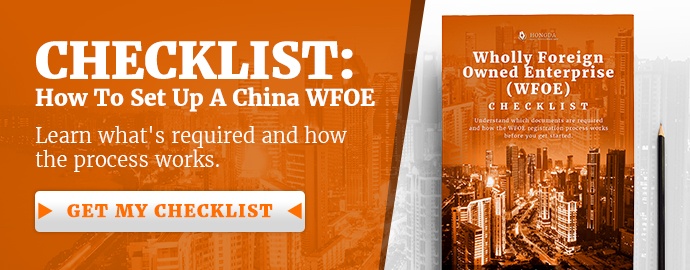How to Set Up a WFOE in China So Things Go According to Plan

A WFOE is one of the more popular investment vehicles for foreigners looking to take on China due to the fact that it is solely owned and managed by the foreign party. Owners take all the profits, they are in full control of their business and enjoy a much higher level of security.
WFOEs in China are mainly categorized into 3 different types that foreign investors can choose from:
- Consulting WFOE
- Manufacturing WFOE
- Trading WFOE (FICE)
Foreign companies and individuals have the legal right to apply for a WFOE on their own, but doing so would require an experienced China hand as their are many tiny details that, if overlooked, may hamper the WFOEs ability to successfully conduct business on the mainland.
It is highly recommended that foreign business owners make use of a registration agent with local knowledge to help smooth over the entire registration process. This being said, it is equally important for companies to invest enough time in planning and knowing what they should be looking out for, all the better to help lay a solid foundation for their WFOE to function the way it is supposed to.
With that I wish to share with you 8 critical items every would-be WFOE applicant should absolutely not overlook!
8 Critical Items for WFOE Set Up in China
I recently came across a whitepaper published by Mike Bellamy, owner of PassageMaker, a US-owned, China-based company that offers clients manufacturing in China access to remotely managed virtual workshops & offices with dedicated staff. His whitepaper on manufacturing options in China for foreign brands goes into some detail about WFOE set up, and points out 8 critical items that those looking to set up a WFOE must not overlook:
1. Scope of Business
If your WFOE is set up to export shoes and later you wish to do electronics, you may have significant roadblocks to deal with.
Companies that engage in operations that fall outside of their business scope run the risk of being fined by local authorities or even having their licenses revoked. It is important for foreign business owners to clearly define the entire scope of their business operations in the AoA so as to avoid having too narrow a scope and transgressing the law.
2. Trading WFOE vs Manufacturing WFOE
Are you clear on the difference and sure which one is best for your needs? Did you know VAT rebates are slightly different for the two WFOEs?
Find out more about the 3 main types of WFOEs here!
3. Need Additional Licensing (domestic sales? Import/export? VAT?)
It is of vital importance for foreign companies to clarify whether or not they are required to obtain additional licenses. This will depend on which type of WFOE you intend on registering and the industry/business you go into.
Here are some examples of licenses for different businesses:
Factory
Environmental approvals
Restaurant
Food and beverage service license
Food trading
Food circulation permit
Import and export business
Customs register license
Record of foreign trade operators
Electronic port card
Self inspection record
Wine trading
Food circulation permit
4. Are There Location or Industry Incentives Offered by China Government to the Wfoe? What’s the Catch?
Taking advantage of government incentives offered to certain industries or in certain locations can certainly help a business get a jump start. For instance, in Shenzhen's Qianhai New District companies in finance, IT, logistics, ecommerce and science and technology are offered special tax breaks such as corporate income tax rate of just 15% (lower than Hong Kong’s 16.5%).
Furthermore, it is also important that you consider a place's infrastructure, its proximity to shipping ports and customer focus according to your industry.
5. China Tax Planning
In China the WFOE has to report monthly and annually, so not only do you need good tax planning, but you also need to budget for the man power to process all the paperwork.
Having your own company in China means that you will have to abide by the accounting standards set in the New GAAP (Generally Accepted Accounting Principles). This means reporting both monthly and annually, which means that some planning has to be done to ensure that enough resources are available to handle this.
Download our FREE China accounting eBook here!
6. Global Tax Planning
The tax rates in HK, PRC and your home country are not the same. Structure your business in China to avoid unnecessary tax exposure while not breaking any laws in any of the jurisdictions where you operate.
Companies typically will use a middle company (such as in HK or in BVI) to hold a China company. This way the company can try to take advantage of any one of these country's low income tax rate, and to keep profit there. At the end of the day it is also based on the operations of the company, its goals and the markets they want to get into.
7. Plan for Profit Repatriation
Making money in China is nice. Spending it back home is even nicer. Make sure you have a plan for how to get your earnings overseas into your pocket back home.
Check out this great pdf that deals with this specific issue here!
8. Budget
Get a firm handle on the true costs to set up and run your business. It is not
uncommon for the investor to sink money into a WFOE only to lose that investment
because they were underfinanced and never got the point where the doors were
open and revenue could be realized.
One of the biggest mistakes that any WFOE owner can make is investing an amount that is not big enough to keep their business running for long enough to reap the rewards of their labor.
There is no minimum amount of registered capital required when setting up a WFOE, but we advise our clients to invest:
Trading WFOE: 300,000RMB
Manufacturing WFOE: 500,000RMB
Consulting WFOE: 100,000RMB
Conclusion
It's without a doubt that a WFOE in China is very useful indeed for foreign companies aiming to open a business here, but the process can be complex.
A WFOE offers unmatched autonomy in China, allowing you to avoid any grey areas, operate legally, make money, and build a strong and stable business foundation in China.
These 8 items are a good start on getting your WFOE off the ground, especially bearing in mind things like the scope of business and tax planning which could often be confusing.
Now you have the knowledge, will you be opening a WFOE? What benefits do you feel it will offer your company? Are you already running a WFOE? Let us know how it's going in the comments below please.





